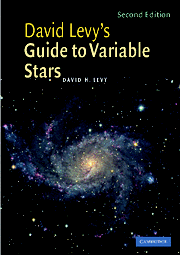Book contents
- Frontmatter
- Contents
- Foreword to the first edition
- Preface
- Acknowledgments
- Part I Getting to know the sky
- Part II Getting to know the variables
- 5 Meeting the family
- 6 Getting started with Cepheids
- 7 Algol, the demon of autumn
- 8 How to estimate a variable
- 9 Names and records
- 10 How your observations help us understand a variable star
- 11 Observing hints
- 12 Observing with CCDs
- 13 Stately and wonderful
- 14 Stars of challenge
- 15 Bright, easy, and interesting
- 16 Betelgeuse: easy and hard
- 17 Not too regular
- 18 Nova? What nova?
- 19 Supernovae
- 20 Clyde Tombaugh's star and the family of cataclysmic variables
- 21 A nova in reverse?
- 22 RU Lupi?
- 23 Orion, the star factory
- 24 Other variable things
- 25 The Sun
- Part III Suggested variables for observation throughout the year
- Part IV A miscellany
- Index
8 - How to estimate a variable
from Part II - Getting to know the variables
Published online by Cambridge University Press: 05 August 2012
- Frontmatter
- Contents
- Foreword to the first edition
- Preface
- Acknowledgments
- Part I Getting to know the sky
- Part II Getting to know the variables
- 5 Meeting the family
- 6 Getting started with Cepheids
- 7 Algol, the demon of autumn
- 8 How to estimate a variable
- 9 Names and records
- 10 How your observations help us understand a variable star
- 11 Observing hints
- 12 Observing with CCDs
- 13 Stately and wonderful
- 14 Stars of challenge
- 15 Bright, easy, and interesting
- 16 Betelgeuse: easy and hard
- 17 Not too regular
- 18 Nova? What nova?
- 19 Supernovae
- 20 Clyde Tombaugh's star and the family of cataclysmic variables
- 21 A nova in reverse?
- 22 RU Lupi?
- 23 Orion, the star factory
- 24 Other variable things
- 25 The Sun
- Part III Suggested variables for observation throughout the year
- Part IV A miscellany
- Index
Summary
Z Ursae Majoris and the AAVSO method
A huge red giant, Z Ursae Majoris displays some unusual behavior in this late stage of its life. Although it usually ranges from magnitude 6.5 to 8.3, it occasionally surprises us. Once I watched it drop to 9.5, more than a full magnitude below its normal minimum.
With the earlier starter stars we used a simple method where “1” represents the brightest and “5” the faintest. Now that we have some understanding of what the process means, we need not use it; now we are going to play the variable star game by the rules as outlined by the American Association of Variable Star Observers.
Look closely at the two charts (Figs. 8.1 and 8.2) for Z Ursae Majoris. Figure 8.1 is designed for binoculars and has north up. Figure 8.2 is meant for Newtonian viewing where the image is usually inverted. South is up, north down, and east and west are exchanged.
In Fig. 8.1 you recognize the Big Dipper, and near the top of the bowl is the circle-and-dot symbol for the variable star. Near other selected stars are numbers like 66, 54, and 64. These numbers represent magnitudes and tenths, but the decimal point is left out to avoid confusion with the other points that represent stars. Therefore, read “66” as “6.6” and so on.
- Type
- Chapter
- Information
- David Levy's Guide to Variable Stars , pp. 39 - 43Publisher: Cambridge University PressPrint publication year: 2005

